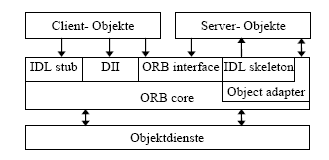JavaBeans are based a component model on the programming language Java. Their goal is it to make the composition of components possible for a complete program at minimum expenditure over graphic surfaces. Also individual Beans can be inserted as applet e.g. on web pages. In Builder Tools can JavaBeans by mouse-click to be joined. Each Bean a Java class, which was modified on configuration and adaptability, is in principle. JavaBeans reveal their characteristics, methods and events in a Builder for the additional adaptability and are This introspektiv.
In them are indicated (characteristics can take several values), bound (divides other Beans changes with) and characteristics with secondary conditions (other Beans can insert a veto before a change) implements.
They are connected loosely by events by means of GET () and set () methods, a JavaBean can so their services other Javabeans offer and again different services stress, by announcing themselves as a receiver and/or snoopers with the appropriate Bean. This loose coupling makes applicable 123 very flexible for JavaBeans
JavaBeans need thereby a container, This a run time environment, in that them to be always can embedded124.
For the development of JavaBeans Sun specifications gave change, in order to place the adherence to the standard surely.
| Evaluation of the JavaBeans125 |
| Advantages | Disadvantages |
|
|
CORBA belonged to distributed object-oriented applications and supported as middleware exactly like COM+ or like the EnterpriseJavaBeans of business procedures in distributed and heterogeneous systems. Middleware platforms must possess This multi-user abilities, on which number of the users, the data and business process scalable its and a high availability possess.
CORBA is thereby only a standard and a specification for the infrastructure of such platforms and component models, which communicate exclusively over interfaces.
The basis for it is short reference architecture Object management Architecture, GRANNY:

Illustration 11: GRANNY architecture of CORBA126
Components of this architecture are short the Client and server objects and the Object Request broker, ORB. This continues to lead the inquiry between the Client and server interfaces in the distributed system, in order not to have to fall back to complicated network minutes. The whole happens by Stubs on the Clientseite and Skeletons on the server side. They simulate the offered object services such as naming, a copying and deletion of objects (Lifecycle services), emergency services, pressures, security agencies, as if they would be locally present. Communication is made exclusively by it. The objects directly can be never accessed. Interfaces, classes and objects are described thereby with the help of the definition language IDL. The interface description supplies that dynamic to Invocation with interface (DII) and replaces unknown interfaces.
The described structure is equivalent to the EnterpriseJavaBeans127
Summary of the pro and cons of the middleware standard:
| Evaluation of CORBA128 |
| Advantages | Disadvantages |
|
|
- 123: See [Balz 2001] S 856 FF
- 124: See [Java 2005]
- 125: See [Balz 2001] P. 896 and [Java 2005] and [point 1999] P. 19 FF and [Lemp 2002] P. 9 FF and [Punz 1999]
- 126: See [Balz 2001] P. 925 and 927
- 127: See [Balz 2001] P. 924 FF and [Wiki 2005] CORBA
- 128: See [point 1999] P. 19 FF and [Balz 2001] P. 924 FF and [Punz 1999]